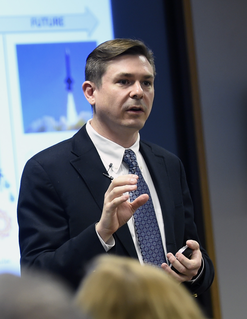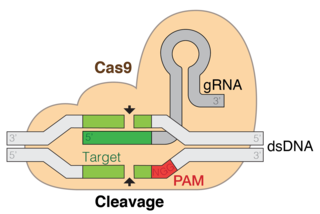Related Research Articles

Bioinformatics is an interdisciplinary field that develops methods and software tools for understanding biological data, in particular when the data sets are large and complex. As an interdisciplinary field of science, bioinformatics combines biology, computer science, information engineering, mathematics and statistics to analyze and interpret the biological data. Bioinformatics has been used for in silico analyses of biological queries using mathematical and statistical techniques.

Biotechnology is a broad area of biology, involving the use of living systems and organisms to develop or make products. Depending on the tools and applications, it often overlaps with related scientific fields. In the late 20th and early 21st centuries, biotechnology has expanded to include new and diverse sciences, such as genomics, recombinant gene techniques, applied immunology, and development of pharmaceutical therapies and diagnostic tests. The term biotechnology was first used by Karl Ereky in 1919, meaning the production of products from raw materials with the aid of living organisms.

Genetic engineering, also called genetic modification or genetic manipulation, is the direct manipulation of an organism's genes using biotechnology. It is a set of technologies used to change the genetic makeup of cells, including the transfer of genes within and across species boundaries to produce improved or novel organisms. New DNA is obtained by either isolating and copying the genetic material of interest using recombinant DNA methods or by artificially synthesising the DNA. A construct is usually created and used to insert this DNA into the host organism. The first recombinant DNA molecule was made by Paul Berg in 1972 by combining DNA from the monkey virus SV40 with the lambda virus. As well as inserting genes, the process can be used to remove, or "knock out", genes. The new DNA can be inserted randomly, or targeted to a specific part of the genome.
Computational biology involves the development and application of data-analytical and theoretical methods, mathematical modelling and computational simulation techniques to the study of biological, ecological, behavioural, and social systems. The field is broadly defined and includes foundations in biology, applied mathematics, statistics, biochemistry, chemistry, biophysics, molecular biology, genetics, genomics, computer science, and evolution.

Synthetic biology (SynBio) is a multidisciplinary area of research that seeks to create new biological parts, devices, and systems, or to redesign systems that are already found in nature.

Nanorobotics is an emerging technology field creating machines or robots whose components are at or near the scale of a nanometer. More specifically, nanorobotics refers to the nanotechnology engineering discipline of designing and building nanorobots, with devices ranging in size from 0.1 to 10 micrometres and constructed of nanoscale or molecular components. The terms nanobot, nanoid, nanite, nanomachine, or nanomite have also been used to describe such devices currently under research and development.

Andrew (Drew) David Endy is a synthetic biologist and Tenured Professor of bioengineering at Stanford University, California.
BiOS is an international initiative to foster innovation and freedom to operate in the biological sciences. BiOS was officially launched on 10 February 2005 by Cambia, an independent, international non-profit organization dedicated to democratizing innovation. Its intention is to initiate new norms and practices for creating tools for biological innovation, using binding covenants to protect and preserve their usefulness, while allowing diverse business models for the application of these tools.

George McDonald Church is an American geneticist, molecular engineer, and chemist. He is the Robert Winthrop Professor of Genetics at Harvard Medical School, Professor of Health Sciences and Technology at Harvard and MIT, and a founding member of the Wyss Institute for Biologically Inspired Engineering. As of March 2017, Church serves as a member of the Bulletin of the Atomic Scientists' Board of Sponsors.

James J. Collins is an American bioengineer, and the Termeer Professor of Medical Engineering & Science and Professor of Biological Engineering at MIT. He is one of the founders of the emerging field of synthetic biology, and has made multiple synthetic biology breakthroughs in biotechnology and biomedicine, including paper-based diagnostics for Zika & Ebola and programmable cells that serve as living diagnostics and living therapeutics to detect-and-treat infections, rare genetic metabolic disorders, and inflammatory bowel disease. Collins is also a pioneering researcher in systems biology, having made fundamental discoveries regarding the actions of antibiotics and the emergence of antibiotic resistance.

BioBrick parts are DNA sequences which conform to a restriction-enzyme assembly standard. These building blocks are used to design and assemble larger synthetic biological circuits from individual parts and combinations of parts with defined functions, which would then be incorporated into living cells such as Escherichia coli cells to construct new biological systems. Examples of BioBrick parts include promoters, ribosomal binding sites (RBS), coding sequences and terminators.

Christopher Voigt is an American synthetic biologist, molecular biophysicist, and engineer.
Mycoplasma laboratorium or Synthia refers to a synthetic strain of bacterium. The project to build the new bacterium has evolved since its inception. Initially the goal was to identify a minimal set of genes that are required to sustain life from the genome of Mycoplasma genitalium, and rebuild these genes synthetically to create a "new" organism. Mycoplasma genitalium was originally chosen as the basis for this project because at the time it had the smallest number of genes of all organisms analyzed. Later, the focus switched to Mycoplasma mycoides and took a more trial-and-error approach.
Do-it-yourself biology is a growing biotechnological social movement in which individuals, communities, and small organizations study biology and life science using the same methods as traditional research institutions. DIY biology is primarily undertaken by individuals with extensive research training from academia or corporations, who then mentor and oversee other DIY biologists with little or no formal training. This may be done as a hobby, as a not-for-profit endeavour for community learning and open-science innovation, or for profit, to start a business.

The iPlant Collaborative, recently renamed Cyverse, is a virtual organization created by a cooperative agreement funded by the US National Science Foundation (NSF) to create cyberinfrastructure for the plant sciences (botany). The NSF compared cyberinfrastructure to physical infrastructure, "... the distributed computer, information and communication technologies combined with the personnel and integrating components that provide a long-term platform to empower the modern scientific research endeavor". In September 2013 it was announced that the National Science Foundation had renewed iPlant's funding for a second 5-year term with an expansion of scope to all non-human life science research.

Diana W. Bianchi is an American medical geneticist and neonatologist noted for her research on fetal cell microchimerism and prenatal testing. She is the director of the Eunice Kennedy ShriverNational Institute of Child Health and Human Development, part of the National Institutes of Health. Bianchi had previously been the Natalie V. Zucker Professor of Pediatrics, Obstetrics, and Gynecology at Tufts University School of Medicine and executive director of the Mother Infant Research Institute at Tufts Medical Center. She also has served as Vice Chair for Research in the Department of Pediatrics at the Floating Hospital for Children at Tufts Medical Center.
ATUM is an American biotechnology company which provides tools for the life sciences, from design and synthesis of optimized DNA to protein production and GMP cell line development.
ATAC-seq is a technique used in molecular biology to assess genome-wide chromatin accessibility. In 2013, the technique was first described as an alternative advanced method for MNase-seq, FAIRE-Seq and DNase-Seq. ATAC-seq is a faster and more sensitive analysis of the epigenome than DNase-seq or MNase-seq.
Christina Smolke is an American synthetic biologist whose primary research is in the use of yeast to produce opioids for medical use. She is a Full Professor of Bioengineering and of Chemical Engineering at Stanford University. She is the editor of The metabolic pathway engineering handbook (2010). She is an advisory board member for Integrative Biology.

CRISPR gene editing is a genetic engineering technique in molecular biology by which the genomes of living organisms may be modified. It is based on a simplified version of the bacterial CRISPR-Cas9 antiviral defense system. By delivering the Cas9 nuclease complexed with a synthetic guide RNA (gRNA) into a cell, the cell's genome can be cut at a desired location, allowing existing genes to be removed and/or new ones added in vivo.
References
- ↑ 1996, Rev. 2003
- ↑ "Cost to Develop and Win Marketing Approval for a New Drug Is $2.6 Billion". Tufts Center for the study of Drug Development. Tufts University. Archived from the original on 2014-11-21. Retrieved 2015-04-26.
- ↑ Ledford, Heidi (2013-07-04). "Bioengineers look beyond patents". Nature. 499 (7456): 16–17. Bibcode:2013Natur.499...16L. doi: 10.1038/499016a . PMID 23823774.